HPE Synergy, real life experience
The Synergy 12000 Frame is a new HPE chassis blade. Beta version of this equipment came to me for testing, in this article I want to share the experience of operating a new basket from HPE and tell how it all works.
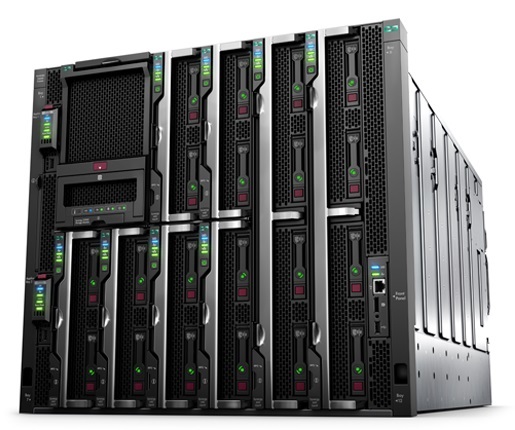
At first glance, the Synergy 12000 chassis looks like an HPE c7000 chassis, but this is only at a glance. In fact, this is a completely different basket developed from scratch, in common with the HPE c7000 is only the height of 10U and the fact that the servers are inserted in front and interconnects in the back (as well as in other blade solutions). The chassis has 12 slots for installing servers + 2 slots for installing Composer-a (responsible for managing the chassis) and the Streamer Image (containing OS images). The decision to reduce server density is due to the forecast for an increase in the thermal package of future generations of CPUs. The new chassis received a backplane with divorced light guides and will support data transmission through photons. While it is hard to imagine exactly where this may be needed, in the photon switch with minimal delays or in computational modules using light instead of electricity, the very fact of the presence of optical fibers indicates HPE’s long-term plans to use the new chassis. By the way, the c7000 chassis has not undergone significant changes for 11 years and maintains compatibility with the entire line of manufactured servers.
Slide rack mounting chassis inspire confidence and do not play under the weight of the basket.
')

The weight of the basket in a full pack is almost 250 kg.

Removable partition for installing double height servers is equipped with two spring clamps and has become more convenient compared to the similar in the C7000.

The Synergy 12000 chassis has slots for installing the following modules:
Consider each of the modules:
The chassis is controlled via the OneView interface in a WEB browser. Composer is a mini x86 server architecture with a modified Linux kernel. OneView is spinning on it, if Composer is pulled out, then it will not affect the performance of the components, but control will not be available. Recycle bins can be grouped together, with all the recycle bins in the group managed through a single OneView interface.
In this configuration, two (Active / Standby) compositors installed in different baskets for fault tolerance are used. Up to 20 chassis can be combined into one group.

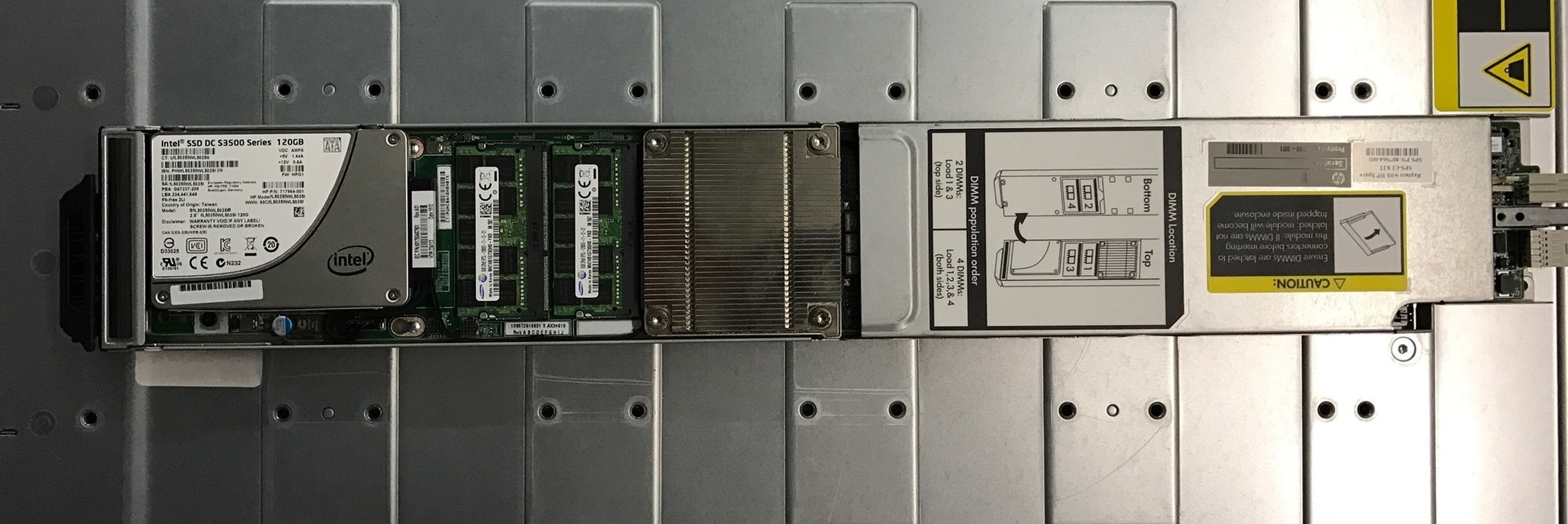
Image Streamer is also a mini server, it contains images of operating systems and it is responsible for uploading the OS to the servers.
Located on the right side of the front panel, it is required for initial setup of the chassis, as well as for resetting to factory settings. Provides connection to active FLM module.

Frame Link Module (FLM) - its tasks include the following functions:
There are two FLM modules in each chassis for fault tolerance. When combining several FLM baskets, modules are connected to form an isolated control network with a ring topology.

Compared to the PS7000, the Synergy PBs have become smaller in size and their power has increased. 6 power supplies provide N + N redundancy for all cart components.
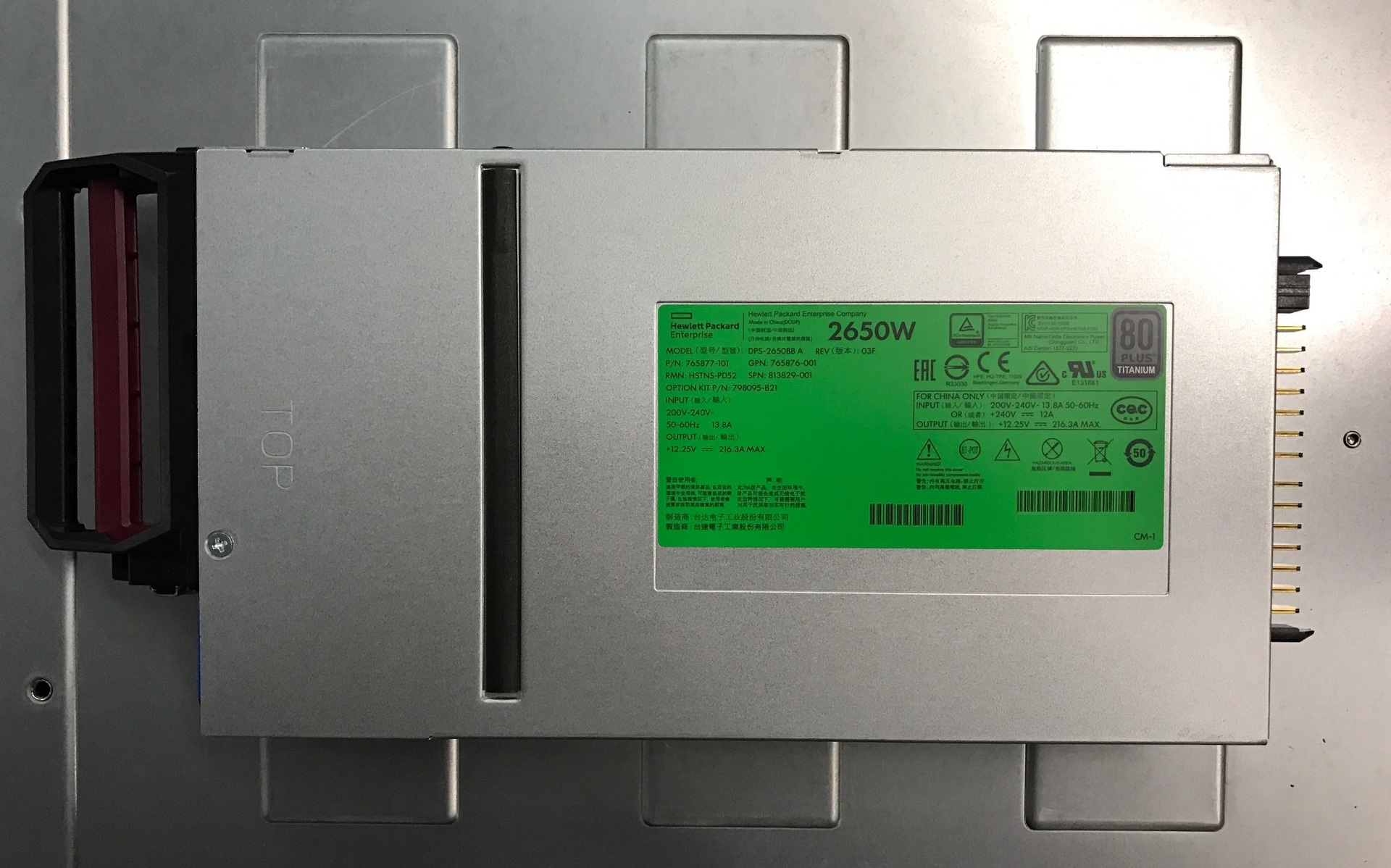
An innovation among the switching modules is the use of satellite switches, which are connected to the master switch located in another basket, so savings are achieved in the number of required uplinks and budget, since satellite switches will cost less. Satellite switch can be connected only to the master switch, up to 4 satellites can be connected to one Master Switch. In the photo below master switch (above the top row of power supplies).
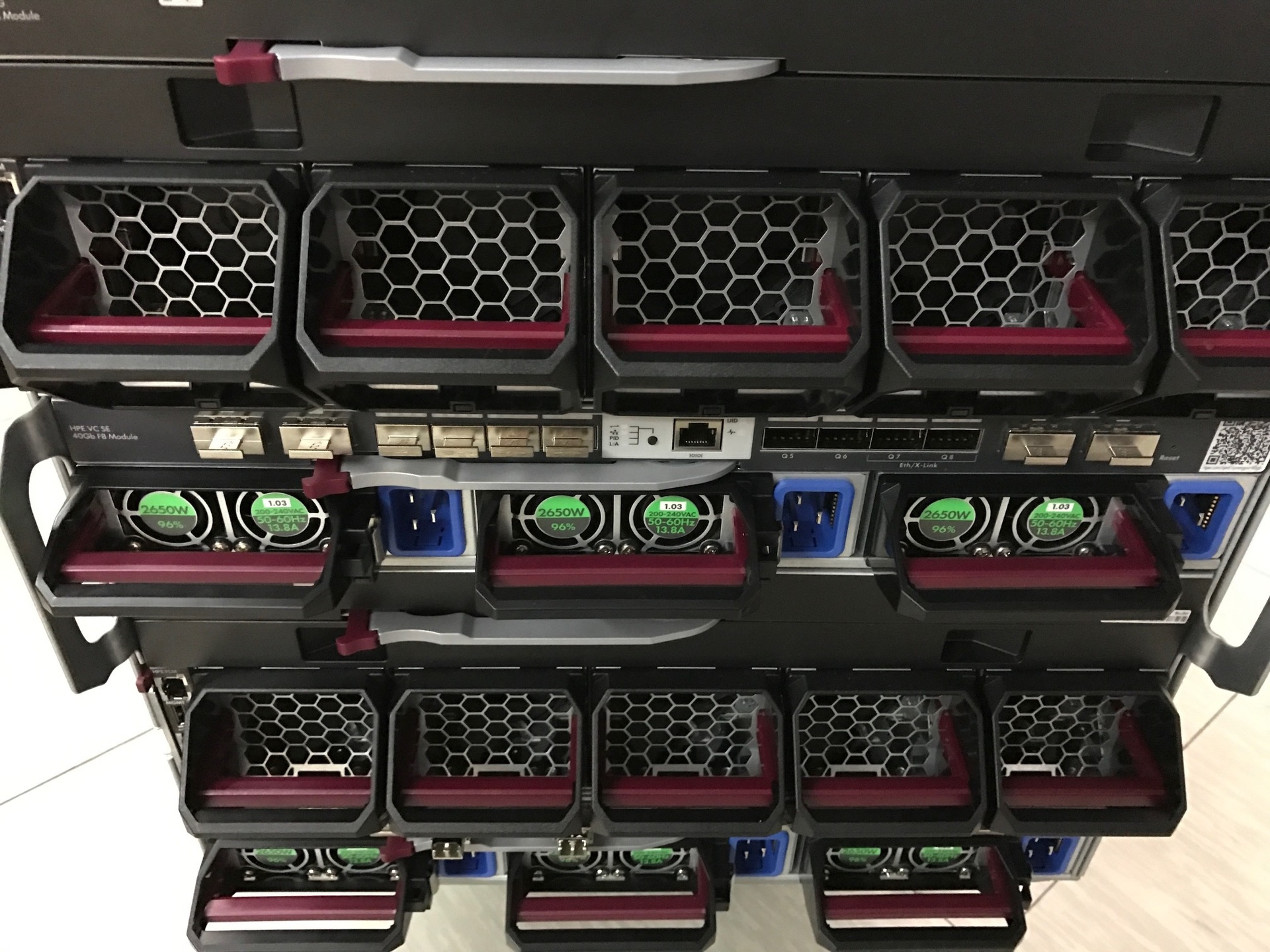
The design of the latch impressed with its monumentality and smooth running.

This server contains fourth-generation Xeon E5 processors, like the bl460 Gen9, but different in design: the RAID controller is now under the disks, the backup power supply has a large capacity, and the number of memory slots has increased to 24.
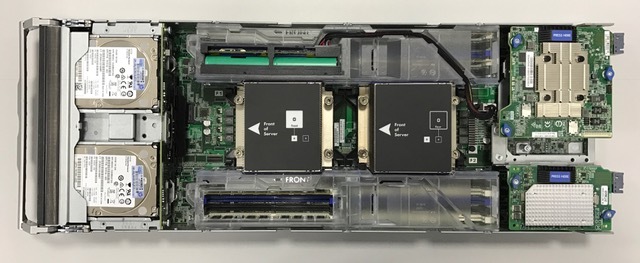
Constructive basket with disks provides the ability to directly connect disks without RAID controller, this option will be necessary when using servers as components of software-defined storage systems (SDS).
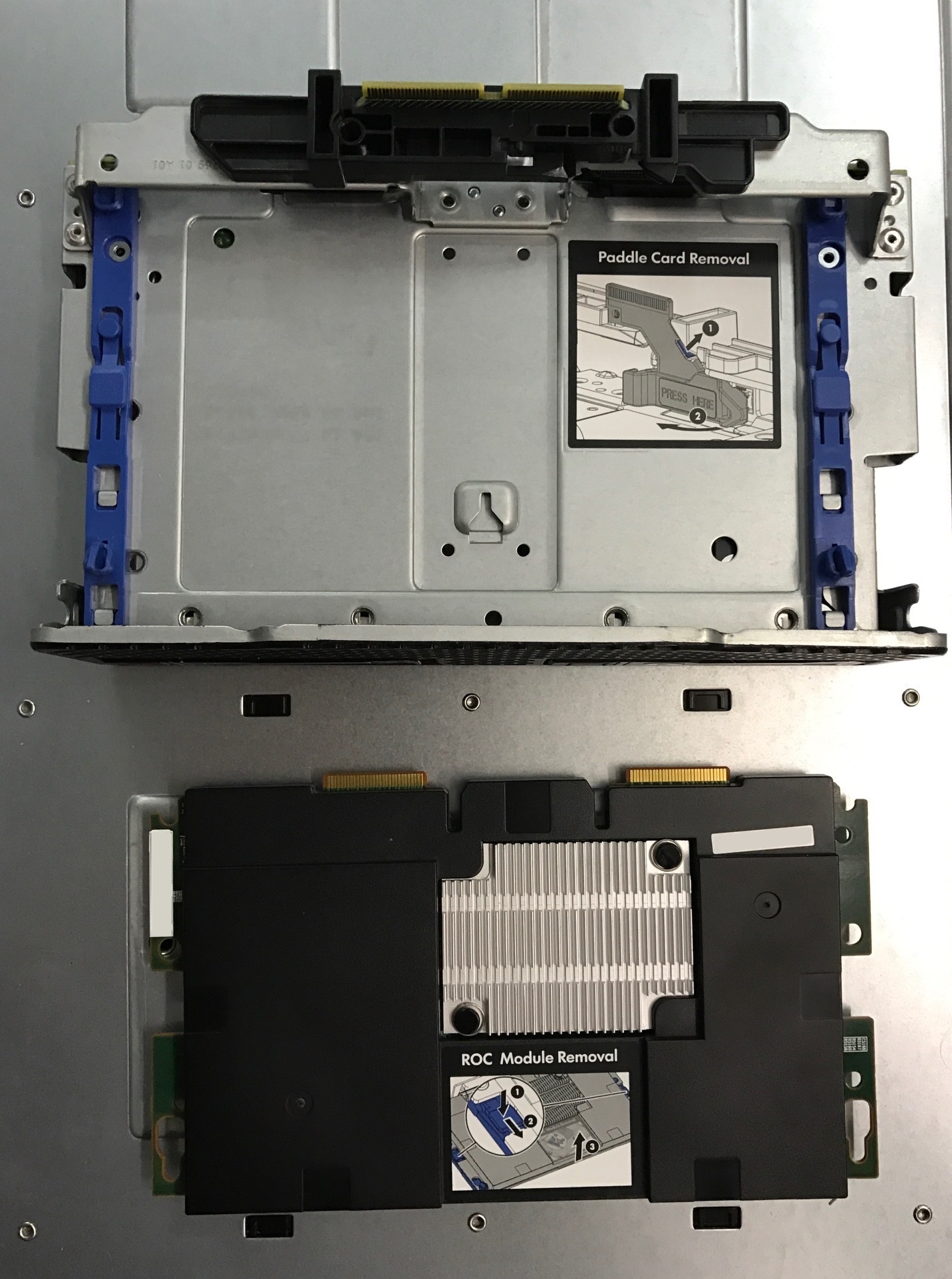
Connectors for connecting mezzanine adapters, as well as connectors on the backplane of the chassis, have become less whimsical and the risk of bending the contacts is now minimized.


The design of the new latch handle is just a gift for escort personnel, since it can be used to carry servers.

All cart components are managed via OneView, Synergy does not have separate management interfaces for VirtualConnect and SAS switches, you cannot even access the iLo WEB interface, although iLo itself is, of course. The OneView interface is simple and straightforward, you just need to get used to the fact that the physical and logical components of the equipment are now separated from each other. All server identifiers (serial number, MAC address, WWN, etc.) can be tied to a specific basket slot, as well as a set of versions of the microcode of the server components, OS drivers and the OS image itself. For example, if the task is to transfer the database server to a new hardware, then this requires:
Hardware profiles can be transferred between physical servers, thereby optimizing resource utilization. In fact, not the equipment itself is now configured, be it a server cart or switch, all settings are stored in a hardware profile that can be applied to any component of the system with a single click. There can be many profiles, but there can be only one active profile for a piece of equipment; if a profile is not assigned to a hardware, it will be idle. The server profile stores comprehensive configuration information including RAID configuration and UEFI / BIOS settings. Great opportunities are opened for DevOps, the control system has support for RestAPI and everything that can be done through the WEB interface can also be done through RestAPI. Another advantage will be the ability through OneView to control the presentation of disk resources on the HPE 3Par arrays.
The OneView menu has the form.

VirtualConnect management.
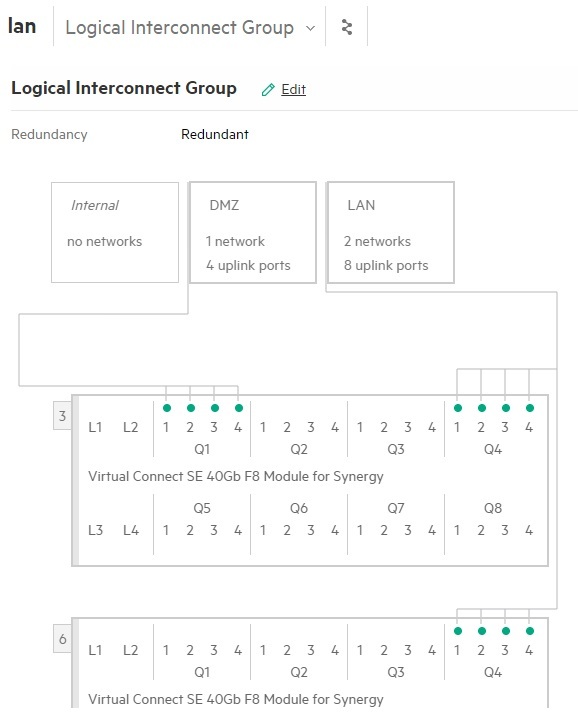
Server management menu.

OneView also includes modeling data center functionality with the ability to obtain data on temperature and power consumption in the rack through thermal sensors in servers and iPDU.


HPE Synergy turned out to be a very interesting product, the rare case when marketing was in second place after the technical part. The new Synergy shopping cart is not positioned as a direct replacement for the C7000, they have slightly different tasks. I believe that the c7000 will exist in parallel with Synergy until the backplane becomes a bottleneck. At the moment, competitors do not have similar solutions yet, but with a high degree of probability the demand for such equipment will grow, thereby giving rise to new offers.
Chassis Synergy 12000

At first glance, the Synergy 12000 chassis looks like an HPE c7000 chassis, but this is only at a glance. In fact, this is a completely different basket developed from scratch, in common with the HPE c7000 is only the height of 10U and the fact that the servers are inserted in front and interconnects in the back (as well as in other blade solutions). The chassis has 12 slots for installing servers + 2 slots for installing Composer-a (responsible for managing the chassis) and the Streamer Image (containing OS images). The decision to reduce server density is due to the forecast for an increase in the thermal package of future generations of CPUs. The new chassis received a backplane with divorced light guides and will support data transmission through photons. While it is hard to imagine exactly where this may be needed, in the photon switch with minimal delays or in computational modules using light instead of electricity, the very fact of the presence of optical fibers indicates HPE’s long-term plans to use the new chassis. By the way, the c7000 chassis has not undergone significant changes for 11 years and maintains compatibility with the entire line of manufactured servers.
Slide rack mounting chassis inspire confidence and do not play under the weight of the basket.
')

The weight of the basket in a full pack is almost 250 kg.

Removable partition for installing double height servers is equipped with two spring clamps and has become more convenient compared to the similar in the C7000.

Chassis Modules
The Synergy 12000 chassis has slots for installing the following modules:
- 12 servers
- 1 composer
- 1 Image Streamer
- 1 Console Connection Module
- 2 FLM modules
- 10 fans
- 6 power supplies
- 6 interconnects
Consider each of the modules:
Composer
The chassis is controlled via the OneView interface in a WEB browser. Composer is a mini x86 server architecture with a modified Linux kernel. OneView is spinning on it, if Composer is pulled out, then it will not affect the performance of the components, but control will not be available. Recycle bins can be grouped together, with all the recycle bins in the group managed through a single OneView interface.
In this configuration, two (Active / Standby) compositors installed in different baskets for fault tolerance are used. Up to 20 chassis can be combined into one group.


Image Streamer
Image Streamer is also a mini server, it contains images of operating systems and it is responsible for uploading the OS to the servers.
Console connection module
Located on the right side of the front panel, it is required for initial setup of the chassis, as well as for resetting to factory settings. Provides connection to active FLM module.

FLM module
Frame Link Module (FLM) - its tasks include the following functions:
- fan control
- power management
- transfer of commands coming from the composer to the final element
- merging several baskets into one group
There are two FLM modules in each chassis for fault tolerance. When combining several FLM baskets, modules are connected to form an isolated control network with a ring topology.

Power supplies
Compared to the PS7000, the Synergy PBs have become smaller in size and their power has increased. 6 power supplies provide N + N redundancy for all cart components.

Switching modules
An innovation among the switching modules is the use of satellite switches, which are connected to the master switch located in another basket, so savings are achieved in the number of required uplinks and budget, since satellite switches will cost less. Satellite switch can be connected only to the master switch, up to 4 satellites can be connected to one Master Switch. In the photo below master switch (above the top row of power supplies).
The design of the latch impressed with its monumentality and smooth running.

Synergy 480 Gen9 Server
This server contains fourth-generation Xeon E5 processors, like the bl460 Gen9, but different in design: the RAID controller is now under the disks, the backup power supply has a large capacity, and the number of memory slots has increased to 24.

Constructive basket with disks provides the ability to directly connect disks without RAID controller, this option will be necessary when using servers as components of software-defined storage systems (SDS).

Connectors for connecting mezzanine adapters, as well as connectors on the backplane of the chassis, have become less whimsical and the risk of bending the contacts is now minimized.


The design of the new latch handle is just a gift for escort personnel, since it can be used to carry servers.

OneView control system
All cart components are managed via OneView, Synergy does not have separate management interfaces for VirtualConnect and SAS switches, you cannot even access the iLo WEB interface, although iLo itself is, of course. The OneView interface is simple and straightforward, you just need to get used to the fact that the physical and logical components of the equipment are now separated from each other. All server identifiers (serial number, MAC address, WWN, etc.) can be tied to a specific basket slot, as well as a set of versions of the microcode of the server components, OS drivers and the OS image itself. For example, if the task is to transfer the database server to a new hardware, then this requires:
- Shut down the old server.
- Insert a new server.
- Wait until the process of automatic server setup and OS filling is completed.
- Configure the application on the server if these settings were not originally included in the OS image.
- Everything!
Hardware profiles can be transferred between physical servers, thereby optimizing resource utilization. In fact, not the equipment itself is now configured, be it a server cart or switch, all settings are stored in a hardware profile that can be applied to any component of the system with a single click. There can be many profiles, but there can be only one active profile for a piece of equipment; if a profile is not assigned to a hardware, it will be idle. The server profile stores comprehensive configuration information including RAID configuration and UEFI / BIOS settings. Great opportunities are opened for DevOps, the control system has support for RestAPI and everything that can be done through the WEB interface can also be done through RestAPI. Another advantage will be the ability through OneView to control the presentation of disk resources on the HPE 3Par arrays.
The OneView menu has the form.

VirtualConnect management.

Server management menu.

OneView also includes modeling data center functionality with the ability to obtain data on temperature and power consumption in the rack through thermal sensors in servers and iPDU.


What did you like
- OneView One Point of Control.
- Rest API support.
- Use hardware profiles.
- The presence of optical links on the backplane chassis.
What did not like
- Unsuccessfully implemented fixing power cables, ties with time can crack.
- On top of the chassis there are holes in which foreign objects can fall.
- Profile changes on Virtual Connect are not applied quickly.
findings
HPE Synergy turned out to be a very interesting product, the rare case when marketing was in second place after the technical part. The new Synergy shopping cart is not positioned as a direct replacement for the C7000, they have slightly different tasks. I believe that the c7000 will exist in parallel with Synergy until the backplane becomes a bottleneck. At the moment, competitors do not have similar solutions yet, but with a high degree of probability the demand for such equipment will grow, thereby giving rise to new offers.
Source: https://habr.com/ru/post/319590/
All Articles